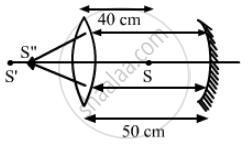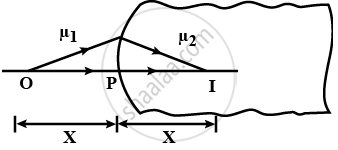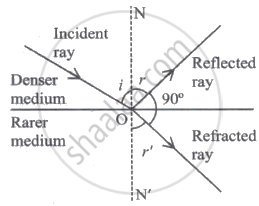Advertisements
Advertisements
Question
A converging lens of focal length 15 cm and a converging mirror of focal length 10 cm are placed 50 cm apart with common principal axis. A point source is placed in between the lens and the mirror at a distance of 40 cm from the lens. Find the locations of the two images formed.
Solution
Given:
Convex lens of focal length (fl) = 15 cm
Concave mirror of focal length (f2) = 10 cm
Distance between the lens and the mirror = 50 cm
Point source is placed at a distance of 40 cm from the lens.
It means the point source is at the focus of the mirror.
Thus, two images will be formed:
(a) One due to direct transmission of light through the lens.
(b) One due to reflection and then transmission of the rays through the lens.
Case 1:
(S') For the image by direct transmission, we have:
Object distance (u) = − 40 cm
fl = 15 cm
Using the lens formula, we get:
\[\frac{1}{v} - \frac{1}{u} = \frac{1}{f}\]
\[\Rightarrow\frac{1}{v}=\frac{1}{15}+\frac{1}{( - 40)}\]
\[=\frac{40 - 15}{40 \times 15}\]
\[\Rightarrow v=\frac{40 \times 15}{40 - 15}\]
Therefore, v is 24 cm to the left from the lens.
Case II:
(S') Since the object is placed at the focus of the mirror, the rays become parallel to the lens after reflection.
∴ Object distance (u) = ∞ ⇒ fl = 15 cm
\[\Rightarrow \frac{1}{v} - \frac{1}{u} = \frac{1}{15}\]
Thus, v is 15 cm to the left of the lens.
APPEARS IN
RELATED QUESTIONS
A point source of light is placed at a distance of 2 f from a converging lens of focal length f. The intensity on the other side of the lens is maximum at a distance
A convex lens has a focal length of 10 cm. Find the location and nature of the image if a point object is placed on the principal axis at a distance of (a) 9.8 cm, (b) 10.2 cm from the lens.
A slide projector has to project a 35 mm slide (35 mm × 23 mm) on a 2 m × 2 m screen at a distance of 10 m from the lens. What should be the focal length of the lens in the projector?
An extended object is placed at a distance of 5.0 cm from a convex lens of focal length 8.0 cm. (a) Draw the ray diagram (to the scale) to locate the image and from this, measure the distance of the image from the lens. (b) Find the position of the image from the lens formula and see how close the drawing is to the correct result.
A converging lens of focal length 15 cm and a converging mirror of focal length 10 cm are placed 50 cm apart. If a pin of length 2.0 cm is placed 30 cm from the lens farther away from the mirror, where will the final image form and what will be the size of the final image?
A 5 mm high pin is placed at a distance of 15 cm from a convex lens of focal length 10 cm. A second lens of focal length 5 cm is placed 40 cm from the first lens and 55 cm from the pin. Find (a) the position of the final image, (b) its nature and (c) its size.
A point object is placed at a distance of 15 cm from a convex lens. The image is formed on the other side at a distance of 30 cm from the lens. When a concave lens is placed in contact with the convex lens, the image shifts away further by 30 cm. Calculate the focal lengths of the two lenses.
Two convex lenses, each of focal length 10 cm, are placed at a separation of 15 cm with their principal axes coinciding. (a) Show that a light beam coming parallel to the principal axis diverges as it comes out of the lens system. (b) Find the location of the virtual image formed by the lens system of an object placed far away. (c) Find the focal length of the equivalent lens. (Note that the sign of the focal length is positive although the lens system actually diverges a parallel beam incident on it.)
A ball is kept at a height h above the surface of a heavy transparent sphere made of a material of refractive index μ. The radius of the sphere is R. At t = 0, the ball is dropped to fall normally on the sphere. Find the speed of the image formed as a function of time for \[t < \sqrt{\frac{2h}{g}}\] . Consider only the image by a single refraction.
Use the above relation to obtain the condition on the position of the object and the radius of curvature in terms of n1and n2 when the real image is formed.
Define the term 'focal length of a mirror'.
Region I and II are separated by a spherical surface of a radius of 25 cm. An object is kept in the region I at a distance of 40 cm from the surface. The distance of the image from the surface is ______.

A spherical surface of radius R separates two medium of refractive indices µ1 and µ2, as shown in figure. Where should an object be placed in the medium 1 so that a real image is formed in medium 2 at the same distance?

A ray of light from a denser medium strikes a rarer medium at an angle of incidence i as shown in the figure. Refracted and reflected rays make an angle of 90° with each other. The angle of reflection and refraction are r and r'. The critical angle is ______.

Define the critical angle for a given pair of media and total internal reflection. Obtain the relation between the critical angle and refractive index of the medium.
Obtain an expression for refraction at a single convex spherical surface, i.e., the relation between μ1 (rarer medium), μ2 (denser medium), object distance u, image distance v and the radius of curvature R.
Assertion: If critical angle of glass-air pair `("μg" = 3/2)` is θ1 and that of water-air pair `("μw" = 4/3)` is θ2, then the critical angle for the water-glass pair will lie between θ1 and θ2.
Reason: A medium is optically denser if its refractive index is greater.
